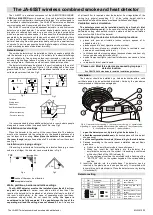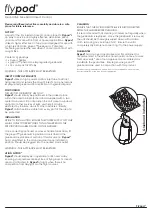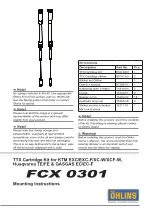
6
JuWel H. Wüster GmbH · A-6460 Imst, Industriezone 19, Tel. 0043-5412-69400 · D-82467 Garmisch Parten kirchen, Bahnhof str. 31, Tel. 0049-8821-1679 · [email protected] · www.juwel.com
Diese Kammer ist weitgehend abgedichtet und
anaerob, sodass das Kompostgut sich bis zum
vollständigen Befüllen der Kammer kaum
verändert. Erst beim Einbringen in die nächs-
te Kammer, die Kompostierkammer, wird
das Kompostgut intensiv belüftet (aerob) und
zersetzt sich rasch unter Abgabe von Feuch-
tigkeit und Reduzierung des Volumens. Die
Wärmeentwicklung ist für Bodenlebewesen
unerwünscht, diese kommen erst in der drit-
ten Kammer, der untersten Kammer, mit dem
weitgehend verrotteten Kompost in Kontakt
und verarbeiten diesen zu Humus. Dadurch,
dass die mittlere Kammer nur in größeren
Zeitabständen in die untere Kammer entleert
wird, und auch keine frischen, nicht verrot-
teten Abfälle eingebracht werden, werden
die Bodenlebewesen in ihrer Tätigkeit nicht
gestört. Gleichzeitig ist eine weitgehende Si-
cherheit gegen schädliche Nagetiere erreicht,
da diese, wenn überhaupt, nur an frischen Ab-
fällen interessiert sind, die in einer der oberen
Kammern, nicht aber am Boden liegen. Bitte
vermeiden Sie in den Komposter Fleischabfäl-
le, aber auch gekochte Lebensmittel (Ausnah-
me Gemüse) zu geben, damit keine Schädlinge
angelockt werden.
sehr geehrte(r) Kunde(in) – in die Entwick-
lung dieses neuartigen Komposters wurden
viele Stunden, auch wissenschaftlicher For-
schung, eingebracht. Wir würden uns freuen,
wenn Sie uns helfen, auch durch Ihre Beob-
achtungen und Berichte weitere wichtige An-
wendungshinweise zu erhalten.
Wir möchten gerne Ihre Mühe, uns Ihre Er-
fahrungen und Tipps zu schildern (möglichst
mit Bildern), mit der kostenlosen Zu sen dung
eines Original JUWEL Kompost-Starters ho-
norieren. Einmal monatlich wird unter allen
Einsendern ein JUWEL Waren gutschein, ein-
lösbar bei Ihrem Fachhändler, in der Höhe von
€ 50,– verlost.
Bei Fragen oder Anregungen erreichen Sie
uns – siehe unten.
GB IMporTANT
Instructions on the use of
Your New Compost Bin
– esseNTIAl INForMATIoN
– please read!
Attention! Do NoT puT IN ANY HoT
AsHes or eMBers!
The composter must not be placed near any
building or shed, minimum distance 20 ft
from inflammable structures - in the un-
likely case of a spontaneous ignition a dan-
gerous fire could emerge.
Dear Customer,
Thank you for purchasing a JUWEL quality
product. For the best possible composting suc-
cess, please read the assembly instructions and
observe the following tips.
The Aeroplus compost bin was developed over
many years of co-operation with the Univer-
sity Institute of Microbiology. It should enable
you to attain good composting results as eas-
ily as possible. The compost is stirred twice
inside the compost bin as it travels through
3 chambers, which spares you the bother of
turning - mixing and aerating - the compost.
The top chamber, which is mostly sealed and
has a lid to protect it from the wind also re-
duces the troublesome infestation with insects
– with the exception of the small fruit flies,
which often come with the fruit and vegetable
scraps. A decisive factor however is that when
the top chamber is emptied, a relatively large
quantity of waste is moved into the middle,
composting chamber, which with the intake of
air heats up more intensively and more quickly
than would be the case if small quantities were
added in each day. In addition, the emptying
of the second chamber, the composting cham-
ber, by means of the external crank and the
rotating base is comfortable and mixes the
compost without manual turning. Thanks to
the chamber system, the raw compost in the
bottom chamber is easier to take out than from
conventional compost bins because it is loose
and it does not mix with fresh waste.
IMporTANT TIps for the assembly
instructions
It is essential that you set up your new
compost bin in a horizontal position (use a
spirit level) on naturally compacted, undis-
turbed ground. On no account should it be set
up on concrete or asphalt because that would
prevent access by soil-dwelling organisms to
the bottom chamber. We urgently recommend
that you place the side walls on a 20-cm-wide
base of concrete or bricks. As the compost in
the two chambers will increase the weight of
your compost bin to up to 100 kg, it would
otherwise sink into soft ground. Look for a
place near the house in a semi-shaded area.
The composting process requires heat but the
compost can become too dry if it is too hot
and it then needs to be watered (the ideal level
of moisture is that of a “wrung-out sponge”).
The 5-digit article numbers in the parts list
are also marked on the injection-moulded
parts for easier identification (with the ex-
ception of small parts, such as cranks and
handles). All outside walls of the compost bin
are locked in place by inserting the studs on
the front walls (flaps) downwards into the slits
in the side walls and pushing the front walls
downwards. This need only be done once for
the outside walls.
When fixing the parts of the upper composting
chamber (pict 7 and 8) please pay attention,
first to fix the screws on the side wall (pict 7)
only afterwards fix the screws form top (pict
8) at the same time pressing the side walls to-
gether. Now please turn the composter com-
pletely to fix the two aluminium frames (d)
from the downside. They are secured with the
already pre-drilled holes on the ribs of the side
walls. Now please turn the composter again
as to fix all parts of the topside.
The cranks for moving the rotating base can be
attached either on the left or on the right side.
Please make sure that if the crank is put on the
left side (viewed from the front of the compost
bin), it will be operated in a clockwise direc-
tion, and if the crank is put on the right, it will
be operated in an anti-clockwise direction.
When the crank is in a horizontal position, the
crank handle is folded back into a recess in
the crank and accordingly locks the rotating
base in a fixed position (initial position). When
mounting the rotating base, please take care
that the smooth side of the base will be on top
later so that when the base is screwed to the
crank shaft, the crank will point backwards,
as shown in the sketch. Later, the crank will be
moved towards the middle of the compost bin
and then the smooth side of the rotating base
will be on top.
BrIeF GuIDe on starting composting
Every day, open the top lid and put organic
compost from the kitchen and the garden into
the top chamber, whereby as far as possible, a
variety of scraps should be put in, such as veg-
etable and fruit leftovers, wilted flowers, waste
clippings from bushes. Do not put in very large
quantities of cut grass at any one time. Please
always close the lid again!
As soon as the top chamber is full, raise the
two side yellow locking levers (P) simultane-
ously and push forwards so that the flap opens.
By pressing down the handles, fix the flap in
the open position. The compost slides into the
next chamber. Use a small garden tool to push
it in further until the top chamber is empty.
If you now add a compost activator – a small
quantity of garden soil also contains enough
soil bacteria – you will create the optimum
preconditions. Now close the flap again by lift-
ing and pulling on the two levers.
Depending on humidity of garbage, mold can
grow in the content of the upper compartment.
According to microbiologists, mold is a nor-
mal sign marking the beginning of the com-
posting process. Please consider that many
useful substances, like antibiotics, are pro-
duced by mold.
Start to fill the top chamber again. In the sec-
ond chamber the compost is now aerated in-
tensively, the two side aeration slide controls
regulate the supply of air. Leave completely
open in the summer. If there is a long peri-
od of dry weather, close somewhere between
half-way and full so that the compost will not
dry out. Keep it closed in the cool season. Due
to the composting action, the compost heats up
and loses volume quickly – you can put sever-
al times the contents of the first chamber into
this chamber until the chamber is completely
full. (If you wish to check on this process, you
can open the back lid flap slightly after first
opening the front lid handle and raising the
latch on the lid flap. Normally, this must be
kept closed however.
Only when the top chamber has to be emptied
again and the second chamber is full, should
the compost be emptied into the bottom cham-
ber by opening out the side crank handle and
by turning it (in a clockwise or in an anticlock-
wise direction) – see tips in the assembly in-
structions). Turn the crank several times and
then lock it in a horizontal position again by
folding back the handle.
Now empty the top chamber into the second
chamber again. In intensive contact with the
soil-dwelling organisms, the final decomposi-
tion of the compost, which has cooled down,
starts. Depending on the season, you can
soon take the raw compost from the bottom
by opening the front or the rear removal flap.
Thanks to the chamber system, there is no risk
of it being mixed with fresh compost.
Why is the compost bin made of 3 cham-
bers? The top chamber is what is referred to as
the collecting chamber. Every day after open-
ing the lid, you can put any organic waste from
the kitchen and the garden into the top cham-
ber. Please always keep the lid closed after fill-






































